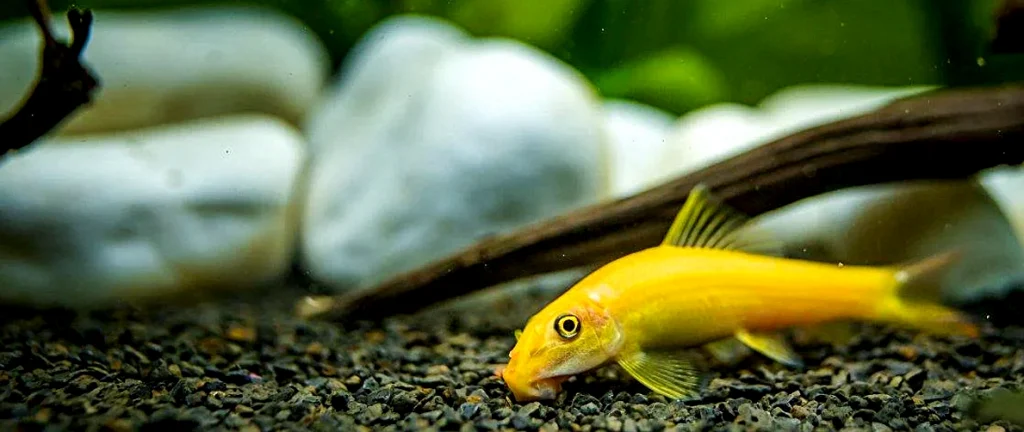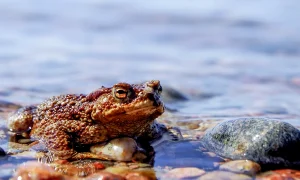The Golden algae eater is a freshwater aquarium fish native to Thailand, Vietnam, and northern India. The Golden algae eaters in the wild are pale clay-colored with black-spotted sides and have a black stripe that runs down their dorsal fin. It is common for these types of fish to have one or more rows of small, white bony plates on the upper portion of their body as well. The Golden algae eater can grow up to about 12 inches in length and live for eight years or more with proper care. Let’s find out more information on the Golden algae eater care guide.
Table of Contents
In Focus
[wptb id="4194" not found ]
Species Overview
The Golden Algae eater is a semi-aggressive fish, bottom-dwelling fish that is very undemanding, making it easy to care for and thus a good choice for beginners. Its natural habitats include large and medium-sized lakes, swamps, and rivers. They prefer rocky bottoms but like shallow water and use their mouths to help them push their way along the bottom.
The Golden algae have long bodies and a small, pointed tail. Golden algae eaters have a large mouth that forms a sucker, which the fish uses to hold/anchor themselves to rocks and sand in rivers or fast-flowing waters.
The Golden algae are non-school, portraying semi-aggressive tendencies. They will fight fish of similar size that invade its territory, including other Golden algae eaters if they are kept in captivity. When kept with peaceful species which they are compatible with, they are extremely peaceful and quite willing to display their colors and come close to the human.
The Golden Algae Eater Care and Tank Requirements
The Golden Algae Eater is a species that is easy to care for, keeping it in an oligo-specific aquarium. The species is quite hardy and can tolerate a wide range of water parameters and temperatures, making it a healthy choice for almost any aquarium. Nevertheless, you need to provide a proper habitat to eliminate stress and prevent diseases. Below are some care guidelines that you must know:
1. Tank size
Since this species can get pretty big, it is recommended to keep it in an aquarium that is at least 50 gallons per fish. This size enables the Golden Algae Eater to avoid the stress of being overcrowded, thus easier to care for. However, it is not recommended if you have other fish that are similar in size.
2. Water parameters
One of the biggest mistakes that beginner hobbyists make when they keep the Golden Algae Eater is to keep the parameters of their aquarium too simple. A properly maintained aquarium that has varied water parameters will help to provide a stress-free environment for the Golden alga eater. When we talk of water parameters, we talk of pH, hardness, and temperature. The pH should be slightly acidic, from 6.8-7.4pH. The temperatures should be between 72-82 degrees Fahrenheit and the hardness should be reversed from soft at 7dH-30dH.
3. Tank setup: Substrate, plants, and decorations
The Golden Algae Eaters are very picky about their habitats. Since they spend most of their time feeding from the bottom and scavenging from the lower parts, a tank that has a sandy substrate, rocks, and large plants will make the fish feel more at home. Place smooth rocks in the sand/gravel in your aquarium and utilize artificial caves for perfect hiding places.
Live plants provide additional support for the Golden Algae Eater, especially during the lighting hours. Plants that are used need to be well rooted in their substrate and will provide shelter for predatory fish as well. Plants like Java fern and Anubias are great. You can also use plants made from plastics to ensure that the Golden Algae Eater will have a safe environment to live in.
When it comes to decorations, you can keep floating bubbles and glass ornaments in your aquarium. You can also use java fern for a fast-growing plant. The lighting should be set to 12-15 hours of light, and many species will enjoy dimming the lights between 1-3 hours during the night.

Diet and Feeding
In the wild, Golden algae eaters feed on algae from rocks and plants. Although algae are their main diet, they also eat proteins from maggots. In captivity, their diet should consist of algae wafers and flakes (algae-based) as well as live foods like brine shrimp, worms, and prawns. With this diet, the Golden algae eater will maintain its natural coloring.
A feeding schedule of 2 times daily of small feedings is typical for this species. You can choose to offer small amounts of food throughout the day or all at once in the morning and evening. Feed them a large variety of foods to provide them with a well-balanced diet.
Diseases
There are no specific diseases that the Golden Algae Eater is susceptible to. Nevertheless, you should keep in mind that many fish species are prone to diseases and parasites. So when keeping any fish, it is important to follow basic health care procedures. Below are the common freshwater tank diseases.
Ich
Ich is a common parasite that can infect freshwater fish. This parasite is also known as white spot disease, and it can affect the eyes, gills, mouth, body, and fins of your fish. White spots with black dots will appear on the body, fins, and tail of your fish. They will get worse over time. The disease is caused by protozoa due to poor water conditions. Ich can be fatal if not treated promptly. If you suspect your fish has ich, isolate them in a quarantine tank with White Vinegar and change 25-50% of the water every other day.

Fin rot
Fin rot is a bacterial disease that affects the scales of fish. The fin rot starts as small white spots that develop into dark red or brown spots over time. It can also affect the eyes and skin of your fish. The disease is caused by bacteria, most commonly, Aeromonas and Pseudomonas. To treat the disease, you need to use fin-rot medication.
Conclusion
The Golden Algae Eater is a species that grows in size and is one of the toughest algae eaters that you can find in the wild. It can grow up to 12 inches and its color varies from golden to silver. With the above Care and Tank requirements, you will be able to care for the species easily.





I have a Golden Algae Eater. About 3-4 days ago it began behaving strangely. Shooting here and there in the tank which it never did before. Now it’s been laying on its side and back for days now. It is still breathing so I don’t want to take it out of the tank. Does anyone know what may be wrong? Is my beautiful Algae suffering?
Hi Terrie,
Sorry to hear that about your fish. Poor feeding, illness, or contaminated water are all plausible explanations. It appears that you had your water tested at a store; however, the results from such tests are typically quite imprecise and often completely meaningless. You should feed Chinese Algae Eaters the same way you would feed any other fish because they don’t eat much algae, especially tank-grown algae.
Golden Algae Eater may swim in a pattern, as if it were trying to scratch an itch or remove something from its body. It’s possible the fish is constructing a nest or cave, as this is something they’ll do even if there aren’t any suitable hiding places.
I recommend you testing the water professionally. There are many testing kits on amazon. If the water is good then I suspect that your fish is old and dying or it’s sick and needs medication.